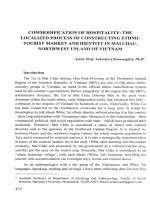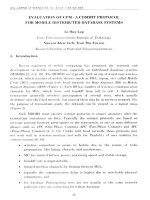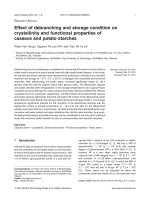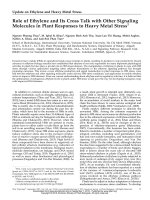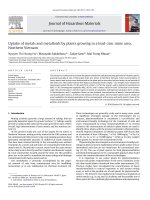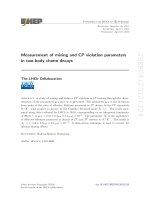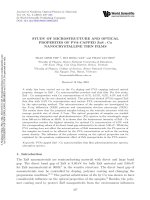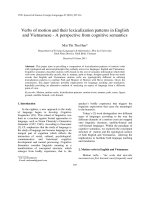DSpace at VNU: Evaluation of anti-HER2 scFv-conjugated PLGA-PEG nanoparticles on 3D tumor spheroids of BT474 and HCT116 cancer cells
Bạn đang xem bản rút gọn của tài liệu. Xem và tải ngay bản đầy đủ của tài liệu tại đây (1.7 MB, 8 trang )
Home
Search
Collections
Journals
About
Contact us
My IOPscience
Evaluation of anti-HER2 scFv-conjugated PLGA–PEG nanoparticles on 3D tumor spheroids of
BT474 and HCT116 cancer cells
This content has been downloaded from IOPscience. Please scroll down to see the full text.
2016 Adv. Nat. Sci: Nanosci. Nanotechnol. 7 025004
( />View the table of contents for this issue, or go to the journal homepage for more
Download details:
IP Address: 201.172.84.233
This content was downloaded on 27/06/2016 at 12:40
Please note that terms and conditions apply.
|
Vietnam Academy of Science and Technology
Advances in Natural Sciences: Nanoscience and Nanotechnology
Adv. Nat. Sci.: Nanosci. Nanotechnol. 7 (2016) 025004 (7pp)
doi:10.1088/2043-6262/7/2/025004
Evaluation of anti-HER2 scFv-conjugated
PLGA–PEG nanoparticles on 3D tumor
spheroids of BT474 and HCT116 cancer cells
Thi Thuy Duong Le1, Thu Hong Pham1, Trong Nghia Nguyen2,
Thi Hong Giang Ngo1, Thi My Nhung Hoang3 and Quang Huan Le1
1
Department of Animal Cell Technology, Institute of Biotechnology, Vietnam Academy of Science and
Technology, 18 Hoang Quoc Viet Road, Cau Giay District, Hanoi, Vietnam
2
Department of NanoBiophotonics, Institute of Physics, Vietnam Academy of Science and Technology,
10 Dao Tan, Hanoi, Vietnam
3
Department of Cell Biology, Faculty of Biology, Hanoi University of Sciences, Viet Nam National
University, 334 Nguyen Trai Road, Thanh Xuan District, Hanoi, Vietnam
E-mail:
Received 28 January 2016
Accepted for publication 22 February 2016
Published 30 March 2016
Abstract
Three-dimensional culture cells (spheroids) are one of the multicellular culture models that can
be applied to anticancer chemotherapeutic development. Multicellular spheroids more closely
mimic in vivo tumor-like patterns of physiologic environment and morphology. In previous
research, we designed docetaxel-loaded pegylated poly(D, L-lactide-co-glycolide) nanoparticles
conjugated with anti-HER2 single chain antibodies (scFv–Doc–PLGA–PEG) and evaluated
them in 2D cell culture. In this study, we continuously evaluate the cellular uptake and cytotoxic
effect of scFv–Doc–PLGA–PEG on a 3D tumor spheroid model of BT474 (HER2overexpressing) and HCT116 (HER2-underexpressing) cancer cells. The results showed that the
nanoparticle formulation conjugated with scFv had a significant internalization effect on the
spheroids of HER2-overexpressing cancer cells as compared to the spheroids of HER2underexpressing cancer cells. Therefore, cytotoxic effects of targeted nanoparticles decreased the
size and increased necrotic score of HER2-overexpressing tumor spheroids. Thus, these scFv–
Doc–PLGA–PEG nanoparticles have potential for active targeting for HER2-overexpressing
cancer therapy. In addition, BT474 and HCT116 spheroids can be used as a tumor model for
evaluation of targeting therapies.
Keywords: PLGA–PEG, docetaxel, active targeting, anti-HER2, cancer cell spheroids, scFv
Classification numbers: 2.04, 2.05, 4.02
1. Introduction
particularly, active targeting drug delivery systems, also
called ligand-mediated targeting carriers, are ligands such as
peptides, monoclonal antibodies, antibody fragments etc
conjugated directly on the surface of nanoparticles to enhance
specific retention and internalization in the targeted disease
cells by overexpressed surface molecules or receptors [1–4].
Overexpression of HER2/neu protein is detected in many
tumors including invasive breast, colorectal, ovarian, pancreatic, stomach and prostate cancers. Therefore human epidermal growth factor receptor 2 (HER2/neu) is one of the
major targets for the design of targeted anticancer drugs [5–7]
Anticancer-drug-loaded nanoparticle formulations have
become an important research area in cancer therapy. Nanocarriers for targeted drug delivery can improve the therapeutic
effects and reduce the side effects of the anticancer drugs. In
Original content from this work may be used under the terms
of the Creative Commons Attribution 3.0 licence. Any
further distribution of this work must maintain attribution to the author(s) and
the title of the work, journal citation and DOI.
2043-6262/16/025004+07$33.00
1
© 2016 Vietnam Academy of Science & Technology
Adv. Nat. Sci.: Nanosci. Nanotechnol. 7 (2016) 025004
T T D Le et al
and high affinity ligand-functionalized polymer nanoparticles
for drug delivery [1]. Application of the biodegradable
polymer poly(lactic-co-glycolic) acid has shown immense
potential as a drug delivery carrier. Polymer- (poly(D,
L-lactide-co-glycolide-) coated polyethylene glycol possesses
many advantages such as biocompatibility, biodegradability
and serum stability for formulating highly stable drug delivery systems [8]. Therefore, it is often used in the literature for
nanoparticle formation [9–11].
In previous research we designed docetaxel-loaded
pegylated poly(D, L-lactide-co-glycolide) nanoparticles conjugated and unconjugated with anti-HER2 single chain antibody (scFv) and evaluated in 2D cell culture. The results
showed that nanoparticle formulations conjugated with scFv
had a significant effect on HER2-overexpressing cancer cells
as compared to HER2-underexpressing cancer cells [12].
Preclinical models closely resembling the original cancer and
predicting clinical outcome have been investigated by pharmaceutical investigators before evaluating in vivo models.
Therefore, three-dimensional (3D) culture systems can be
applied as a preclinical effective tool for the development of
anticancer drugs and treatments [13, 14]. Multicellular tumor
spheroids are formulated by mimicking the 3D network of the
cellular–matrix and cell–cell interactions. Tumor spheroids
are similar to many features of in vivo tumor-like development patterns within human tumor tissue, especially avascular
tumor nodules in terms of morphology and growth kinetic
properties [15–17], and they more closely mimic the physiologic environment of living organisms compared to conventional monolayer culture systems [18].
The objective of this study is to evaluate the internalization and cytotoxicity of docetacel-loaded PLGA nanoparticles (Doc–NPs) conjugated and unconjugated with single
chain anti-HER2 antibody using a three-dimensional multicellular spheroid model of BT474 (HER2-overexpressing)
and HCT116 (HER2-underexpressing) cancer cells.
Human breast cancer cell line BT474 and human colon
cancer cell line HCT116 (American Type Culture Collection)
were obtained from the Institute of Biotechnology (VAST).
The cell lines were cultivated in Dulbecco’s modified Eagle’s
medium (DMEM) supplemented with 10% fetal bovine serum
and 1% penicillin–streptomycin at 37 °C in a humidified
incubator with 5% CO2.
2.2. Methods
2.2.1. Synthesis of scFv–Doc–PLGA–PEG nanoparticles.
The Doc-encapsulated PLGA–PEG copolymer nanoparticles
(Doc–NPs) and the conjugation of anti-HER2 scFv to Doc–
NPs was synthesized and characterized in our previous study
[12]. Briefly, 10 mg of PLGA–PEG copolymer and 1 mg of
Doc were dissolved in acetone. The mixtures were poured
into Millipore water solution with solvent:water=1:5.
Nanoparticles were formed and gently stirred at room
temperature for 4–5 s to evaporate the organic solvent.
Then, 2 ml of Doc–NP solution (4 mg ml−1) was incubated
with 200 μl of 4 mM 1-ethyl-3-(3-dimethylaminopropyl)
carbodiimide (EDC) and 200 μl of 10 mM NHS for 15 min
at room temperature with gentle stirring. The activated
particles were covalently linked to 100 μl of scFv
(1 mg ml−1) for 2 s at room temperature and gently
vortexed. The Doc–NPs conjugated with anti-HER2 scFv
were purified from unconjugated proteins by ultrafiltration.
The average size of nanoparticle derivatives was analyzed by
dynamic light scattering (DLS). The zeta potential of NPs was
evaluated using the electrophoretic mode of a Zetasizer 3000
HS (Malvern Instruments, UK). A transmission electron
microscopy (TEM) system (JEOL JEM-1010, USA) was used
to determine the shape and surface morphology of
nanoparticles produced.
2.2.2. Formation of spheroids. The spheroid model is formed
using the hanging drop method. After culturing, cells of
BT474 and HCT116 reached growth phase (about 80% of
culture dish) and were trypsinized and resuspended at a
concentration of 1×106 cells/ml. Twenty microliters of the
cell solution was dropped on the lid of a 100 nm tissue culture
plate and incubated for 4 days at 37 °C and 5% CO2 to form
spheroids.
2. Materials and methods
2.1. Materials
Poly(D, L-lactide-co-glycolide) (PLGA, lactide:glycolide
50:50), bifunction poly(ethylene glycol) 2-aminoethyl ether
acetic acid (NH2–PEG–COOH), 1-ethyl-3-(3-dimethyllaminopropyl) carbodiimide (EDAC) and N-hydroxysuccimide
(NHS) were obtained from Sigma-Aldrich (St Louis, MO,
USA). Docetaxel anhydrous was purchased from Shanghai
Bioman Pharma (Shanghai, China). Monoclonal mouse antihexahistidine antibodies were purchased from Abcam (Cambridge, MA, USA); anti-mouse secondary antibodies conjugated with Alexa Fluor 546 were purchased from Santa
Cruz Biotechnologies (Santa Cruz, CA, USA). Molecular and
cellular biology buffers were purchased from Sigma and all
other organic solvents were analytical grade from Fisher
Scientific.
2.2.3. Penetration analysis of scFv–Doc–PLGA–PEG. The
cellular uptake of Doc–NPs and scFv–Doc–NPs by BT474
and HCT116 cellular spheroids was observed by fluorescence
microscopy. Tumor spheroids were grown in a 96-well plate
for 4 days before experiments. The spheroids were then
incubated with 100 μg ml−1 of Doc–NPs or scFv–Doc–NPs
for 1 h at 37 °C. After washing twice with phosphate-buffered
saline (PBS), samples were incubated with monoclonal
mouse anti-hexahistidine primary antibody for 1 h at 4 °C
and then washed three times with PBS 1x. Samples were
incubated with Alexa Fluor 546 goat anti-mouse secondary
antibody for 1 h at room temperature and washed with PBS
1x three times. Images from transmitted light, tomographic
2
Adv. Nat. Sci.: Nanosci. Nanotechnol. 7 (2016) 025004
T T D Le et al
Figure 1. TEM images of (a) NPs, (b) Doc–NPs and (c) scFv–Doc–NPs.
Figure 2. The diameter of spheroids after lowering hanging drops and culturing for 24 s before treatment using a 10× objective lens.
images were analyzed using Olympus cellSensTM microscope
imaging software.
scanning and the 3D image were analyzed using a Nikon Ti E
Eclipse microscope equipped with a Ti-TIRF illumination
unit and confocal system.
3. Results and discussion
2.2.4. Spheroid growth and necrotic score. To investigate the
3.1. Characteristics of nanoparticles
effect of nanoparticle formulations on size growth and
necrotic score formulation, tumor spheroids of BT474 and
HCT 116 cells grown in 96-well plate were then incubated
with 200 μl of Doc, Doc–NPs or scFv–Doc–NPs (15 μg ml−1
calculated by Doc) for 5 days at 37 °C. Then spheroids were
imaged using an Olympus IX83 Inverted microscope, and the
Docetaxel-loaded nanoparticles were prepared by the nanoprecipitation method. Transmission electron microscopy
showed that the morphology of nanoparticles was spherical
(figure 1) with a mean size and zeta potential of 105 nm
and −25 mV, respectively. Conjugation of Doc–NPs with
3
Adv. Nat. Sci.: Nanosci. Nanotechnol. 7 (2016) 025004
T T D Le et al
Figure 3. Confocal fluorescence microscopy images of BT474 and HCT116 spheroids treated with scFv–Doc–NPs for 30 min with (a)
transmitted light, (b) bright field, (c) the 3D image and (d) tomographic scanning of an intact BT474 spheroid.
fluorescence scanning microscopy [12]. Moreover, the scFv–
Doc–NPs showed stronger cytotoxicity on BT474 cells than
MDA-MB-231 cells in a 2D cell model.
anti-HER2 single chain antibody fragments by covalent
coupling via crosslinkers EDC and NHS resulted in an
increase of mean size and zeta potential of targeted nanoparticles (scFv–Doc–NPs) to 135 nm and −28 mV respectively. The scFv–Doc–NPs bound specifically to BT474 cells
(HER2 positive) but no MDA-MB-231 cells (HER2 negative)
were investigated by flow cytometry and their internalization
by the targeted cancer cells was revealed by confocal
3.2. Analysis of cellular uptake
The human breast cancer cell line BT474 (HER2 overexpressing) was chosen for cytotoxicity studies. The cell line
4
Adv. Nat. Sci.: Nanosci. Nanotechnol. 7 (2016) 025004
T T D Le et al
Figure 4. BT474 spheroids. (a) The effect of nanoparticle formulations on central necrosis after incubation for 5 days: (A) control, (B) Doc,
(C) Doc–NPs and (D) scFv–Doc–NPs. (b) Diagram of growth size after treatment for 5 days.
comes from breast epithelial tissue, making it a good HER2overexpressing cytotoxicity model [19]. Another cell line that
was used in this study is the human epithelial colorectal
carcinoma cell line HCT 116. This cell line has low expression of HER2 receptor [20] and the cells represent a model of
low-level HER2 expression. To visualize cellular uptake of
targeted nanocarriers, many studies had linked fluorescent
factors on the surface of nanoparticles [21]. In this study a
six-histidine tag fused with anti-HER2 scFv antibodies can be
used to study the binding activity and cellular uptake of
5
Adv. Nat. Sci.: Nanosci. Nanotechnol. 7 (2016) 025004
T T D Le et al
Figure 5. HCT116 spheroids. (a) The effect of nanoparticle formulations on central necrosis after incubation for 5 days: (A) control, (B) Doc,
(C) Doc–NPs and (D) scFv–Doc–NPs. (b) Diagram of growth size after treatment for 5 days.
small spheroids (<100 μm) do not expose the complexity of
tumor tissue with slow growth, while larger spheroids
(>500 μm) with rapid development result in the limited diffusion of oxygen and nutrients [22]. In this study, the average
scFv–Doc–NPs such that it did not change their characterization in vitro.
The size of spheroids that is suitable for the full exchange
of oxygen and nutrients is about 100–500 μm. However,
6
Adv. Nat. Sci.: Nanosci. Nanotechnol. 7 (2016) 025004
T T D Le et al
sizes of BT474 and HCT116 spheroids are 193.91 μm and
268.47 μm, respectively (figure 2).
Spheroids of two cell lines were treated with 100 μg of
scFv–Doc–NPs; the fluorescence intensity through an antiHis tag antibody with Alexa Fluor 546 observed by confocal
scanning microscopy in BT474 spheroids was stronger than
in HCT116 spheroids (figure 3). In particular, when an intact
BT474 spheroid was scanned at specific depths the tomographic scanning images (figure 3(D)) were taken every 2 μm
from the top to the bottom and the 3D image (figure 3(C)) was
reconstructed using tomography. These results showed that
the permeability and cellular uptake of scFv-Doc–NPs for the
BT474 spheroid were more effective than those for the
HCT116 spheroid.
Acknowledgments
This work was supported by the state program ‘ApplicationOriented Basic Scientific Research’, project number 04/
2011/HĐ-NCCBUD, and in part by grants from the State
Technological Science Program, project number KC.10.19/
11-15 (Ministry of Science and Technology, Vietnam).
References
[1] Sadat S M, Saeidnia S, Nazarali A J and Haddadi A 2015 Curr.
Cancer Drug Targets 15 71
[2] Kamaly N, Xiao Z, Valencia P M, Radovic-Moreno A F and
Farokhzad O C 2012 Chem. Soc. Rev. 41 2971
[3] Koshkaryev A, Sawant R, Deshpande M and Torchilin V 2013
Adv. Drug Deliv. Rev. 65 24
[4] Byrne J D, Betancourt T and Brannon-Peppas L 2008 Adv.
Drug Deliv. Rev. 60 1615
[5] Koeppen H K, Wright B D, Burt A D, Quirke P and
McNicol A M 2001 Histopathology 38 96
[6] Mitri Z, Constantine T and O’Regan R 2012 Chemother. Res.
Pract. 743193
[7] Santin A D, Bellone S, Roman J J, McKenney J K and
Pecorelli S 2008 Int. J. Gynaecol. Obstet. 102 128
[8] Makadia H K and Siegel S J 2011 Polymers (Basel) 3 1377
[9] Rietscher R, Czaplewska J A, Majdanski T C, Gottschaldt M,
Schubert U S, Schneider M and Lehr C M 2016 Int. J.
Pharm. (doi:10.1016/j.ijpharm.2016.01.021)
[10] Mohammadinejad S, Akbarzadeh A, Rahmati-Yamchi M,
Hatam S, Kachalaki S, Zohreh S and Zarghami N 2015
Asian Pac. J. Cancer Prev. 16 3753
[11] Zhang K, Tang X, Zhang J, Lu W, Lin X, Zhang Y, Tian B,
Yang H and He H 2014 J. Control. Release 183 77
[12] Le D T T, Dang L T M, Hoang N T M, La H T and
Nguyen H T M 2015 J. Nanomed. Nanotechnol. 6 267
[13] Falkenberg N, Höfig I, Rosemann M, Szumielewski J,
Richter S, Schorpp K, Hadian K, Aubele M,
Atkinson M J and Anastasov N 2016 Cancer Med.
(doi:10.1002/cam4.630)
[14] Eckerdt F, Alvarez A, Bell J, Arvanitis C, Iqbal A, Arslan A D,
Hu B, Cheng S Y, Goldman S and Platanias L 2016
Biotechniques 60 43
[15] Friedrich J, Seidel C, Ebner R and Kunz-Schughart L 2009
Nat. Protoc. 4 309
[16] Friedrich J, Ebner R and Kunz-Schughart L A 2007 Int. J.
Radiat. Biol. 83 849
[17] Timmins N E and Nielsen L K 2007 Methods Mol. Med.
140 141
[18] Abbott A 2003 Nature 424 870
[19] Hathaway H J, Butler K S, Adolphi N L, Lovato D M and
Belfon R 2011 Breast Cancer Res. 13 R108
[20] LaBonte M J, Wilson P M, Fazzone W, Russell J, Louie S G,
El-Khoueiry A, Lenz H J and Ladner R D 2011 Cancer Res.
71 3635
[21] Hussain A F, Krüger H R, Kampmeier F, Weissbach T,
Licha K, Kratz F, Haag R, Calderón M and Barth S 2013
Biomacromolecules 14 2510
[22] Ivanov D P, Parker T L, Walker D A, Alexander C,
Ashford M B, Gellert P R and Garnett M C 2014 PLoS ONE
9 e103817
3.3. The effects on spheroid growth and necrotic score
BT474 and HCT116 spheroids treated with 100 μg of Doc–
NPs (both non-targeted and targeted) and observed for 5 days
were imaged with an Olympus IX83 inverted microscope
with an interval of 1 day, and the images were analyzed using
Olympus cellSensTM microscope imaging software. All images of spheroids were converted to simplified threshold
images under the same conversion conditions and then the
edges of the spheroids were recorded using a selection tool.
Diameters of the spheroid edges were measured initially as
pixels, and converted to micrometers by comparison to a
reference length. The results showed that scFv–Doc–NPs
have a more potent inhibitory effect than the other aqueous
solution forms at a dose of 15 μg Doc in both BT474
(figure 4) and HCT116 spheroids (figure 5) through spheroid
growth and formation of necrotic score. Targeted nanoparticles decreased the size and increased the necrotic score of
HER2-overexpressing tumor spheroids—BT474—during 5
days of treatment (images (D) and (E) of figure 4(a)). However, both Doc–NPs and scFv–Doc–NPs have the same effect
on HER2-underexpressing tumor spheroids—HCT116 (images (C), (D) and (E) of figure 5(a)). Thus, the toxicity of Doc–
NPs conjugated with anti-HER2 scFv was more effective for
BT474 spheroids than HCT116 spheroids.
4. Conclusion
BT474 and HCT116 spheroids developed by the hanging
drop method can be used as a tumor model for evaluation of
HER2-targeted therapies before further in vivo applications.
Encapsulation of docetaxel in a nanopolymer formulation
conjugated with anti-HER2 scFv improved permeability and
cytotoxicity in the HER2-overexpressing multicellular
spheroid model. Thus, this drug delivery system has been
proposed as a potential approach to improve the efficacy of
nanoparticles in active targeting for HER2-overexpressing
cancer therapy.
7

